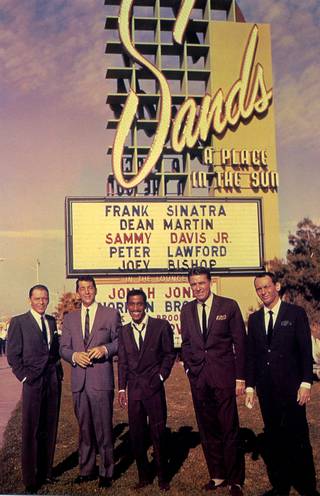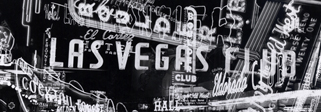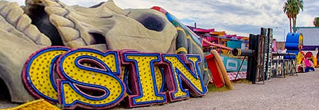Thursday, May 15, 2008 | 3 a.m.
It’s quarter to three, there’s no one in the place
Except you and me
So set ’em up Joe,
I’ve got a little story I think you should know…
After the losing dice were tossed, a high roller sitting ringside and sipping a drink on the house could empathize with Frank Sinatra's song floating through the darkness of the Copa Room.
The Man, the Chairman of the Board, and his music made magic, helping people forget their troubles.
Those pangs of loss (lost cash or lost love) evaporated in an era when Frank, Dean, Sammy, Peter and Joey came to the Sands, "A Place in the Sun,” on the Las Vegas Strip.
As improbable as this elegant quintet’s launch in the desert seems, the Rat Pack attracted an avalanche of followers around the world in the early 1960s.
Although Las Vegas appeared on showbiz maps all over the country, the year 1960 vaulted the Rat Pack and Las Vegas into the spotlight as the Entertainment Capital of the World.
Between booze and broads, the Rat Pack became a legend as the best entertainment American audiences had seen or heard in the post-World War II era.
The women who hung out with the Rat Pack were legend: Lauren Bacall, Juliet Prowse, Angie Dickinson, Shirley MacLaine, Marilyn Monroe.
The Rat Pack started out as a drinking club in Hollywood.
Crooner Frank Sinatra joined the Holmby Hills drinkers when Bogie — Humphrey Bogart that is — led the group that included Bogart’s wife, Lauren Bacall; singer Judy Garland and husband Sid Luft; Irving Lazar, who became the famous literary agent “Swifty” Lazar; David Niven; restaurateur Mike Romanoff; and other entertainment and literary luminaries.
The pack was also known as The Summit, referring to a conference among world leaders: U.S. President Dwight Eisenhower, French President Charles de Gaulle and Soviet Union Premier Nikita Krushchev.
As the Hollywood crowd boozed it up on a Los Angeles to Las Vegas train trip to catch Noel Coward’s solo cabaret act on June 26, 1955, at the Desert Inn, the group’s name popped out of Bacall’s mouth: “You look like a goddamn rat pack.”
The name stuck.
But Sinatra didn’t like “Rat Pack.” So he changed it to the Clan, until Sammy Davis Jr. said he didn’t like that term. Sensitive to ethnic slurs, Sinatra tried to return to The Summit, but to the world the group became the Rat Pack.
Sinatra championed underdogs and civil rights from the beginning of his career. He won a special Academy Award for the 1945 film “The House I Live In,” a 10-minute documentary in which he speaks of ethnic peace to a racially divisive street gang. When Bogart died on Jan. 14, 1957, after a stroke, the Hollywood rat pack’s reign ended. Sinatra created and nurtured the kernel that became the Rat Pack in Las Vegas.
The pack members as individuals entertained up and down the Strip: Sinatra at the Desert Inn, Sammy Davis at the Last Frontier, Dean Martin and Jerry Lewis at the Flamingo. Once those contracts expired, the stars moved to the Sands.
With its soaring entrance and wood-paneled casino, the Sands seemed swank and elegant compared to Vegas glitz at other Strip hotels. Softer lighting and very private gambling rooms drew high rollers like a moth to the Strip’s neon lights.
In January 1960, Sinatra — the Rat Pack’s designated leader — arrived to start filming the original “Ocean’s Eleven” movie. Joining him were Martin, Davis, Peter Lawford (married to Patricia Kennedy, John F. Kennedy’s sister) and comedian Joey Bishop, who played straight man to the antics of the others.
While filming in 1960, Rat Pack members did two shows in the Copa Room each evening, then spent the night partying. No one knew when the film might wrap, but one of the pack usually showed up on the set between 3 and 6 p.m.
The original “Ocean’s Eleven” was a fun, frothy caper on how to steal millions from casinos. In 2001 Steven Soderbergh and George Clooney teamed up to remake the casino heist movie, “Ocean’s Eleven,” followed by “Ocean’s Twelve” in 2004 and “Ocean’s Thirteen” in 2007, all in glorious color with more flair and high-tech gadgets for the thieves than the original.
After the 1964 film “Robin and the Seven Hoods,” the Las Vegas Rat Pack dissolved in the movie-going public’s mind.
Well that’s how it goes, and Joe I know your gettin’ anxious to close…
The Rat Pack in Las Vegas grew gradually.
It began innocently enough, as Frank, Dean or Sammy would start entertaining onstage alone, then one or another would join the fun. Soon Joey Bishop might introduce Dean, joining the others in the songs and schtick. From working in twos and threes, they soon became The Rat Pack.
For years, Frank or Dean would cradle Sammy in their arms, offering him to the audience, and say, “I’d like to thank the NAACP (National Association for the Advancement of Colored People) for this award.” It brought down the house.
Enthusiastic tourists spread the word and the Rat Pack at the Sands drew worldwide attention. The gossip columnists wrote rave reviews after gobbling up press releases from Sands publicist Al Freeman. And the price of a ticket to see the Rat Pack at the Sands? Dinner and a minimum of two drinks: $5.95 per person.
Sen. John F. Kennedy, before becoming president, came to Las Vegas on Feb. 7, 1960, just as the entire Rat Pack began an astonishing gig at the Sands during its heyday. Chairman of the Board Sinatra, whose mother, Dolly, became a Democratic Party operative in Hoboken, N.J., introduced JFK sitting ringside.
Sinatra adapted and recorded the song, “High Hopes,” as a campaign song for JFK’s 1960 U.S. presidential campaign. The song came from Sinatra’s 1959 film, “A Hole in the Head.” The film’s song won an Oscar for lyrics by Sammy Cahn and Jimmy Van Heusen. Both later worked on the original “Ocean’s Eleven.”
The Rat Pack grabbed the spotlight at the Sands and a generation swooned at their antics on and off stage. For a magical few years in the 1960s they became the epitome of cool, clowning on stage, partying all night.
When the pack cut through the Sands — or any other casino, hotel or showroom, for that matter — they lit up the place. The others always followed Frank’s lead.
“I’ve never seen anyone else create so much excitement as Frank Sinatra did when he walked into a room,” jazz saxophonist Jimmy Mulidore told the Sun.
“Everybody who was anybody went to see Frank ... He walks into a room and it’s like Joe DiMaggio hit a home run to win the World Series,” Mulidore said.
The fun and easy-going style of the Rat Pack often hid a darker side. Sinatra and Davis had a falling out, but patched up their differences. And Sinatra fell out of favor with the Kennedys when he asked Attorney General Bobby Kennedy to leave his “friend,” mob boss Sam Giancana, alone in late 1961.
A federal judge sitting on the bench in Las Vegas recalled how Sinatra once ordered a screwdriver while poolside at the Sands. When the then-fresh-faced 18-year-old lifeguard offered the tool instead of the drink, Sinatra leapt up and threw every chaise lounge into the pool.
In Las Vegas the Rat Pack legend grew.
Make it one for my baby and one more for the road.
The Rat Pack at their zenith had money and power. But most of all, they had fun, according to authors Lawrence J. Quirk and William Schoell in their book, “The Rat Pack: Neon Nights With the Kings of Cool.”
All of them had talent, exuberance and energy to burn, Quirk and Schoell say. They had a blast until the late 1960s. Those five together made magic from jazz, honky tonk and blues before the rock ’n’ rollers hit the scene.
The America of the Rat Pack years learned how to swing, how to break sound barriers and ethnic barriers, and it brought an electricity to entertainment never equaled, author Shawn Levy says in his book “Rat Pack Confidential.”
Levy describes the Rat Pack and those heady years:
“It was the high point of their lives and a midlife crisis.
“It was the acme of the American century and a venal, rancid, ugly sham.
“It was the Rat Pack.
“It was beautiful.”
(Thanks to Harold Arlen and Johnny Mercer for the lyrics to One for My Baby).


 Explore Las Vegas’ past and present
Explore Las Vegas’ past and present Boomtown: The Story Behind Sin City
Boomtown: The Story Behind Sin City Neon Boneyard: A 360° look
Neon Boneyard: A 360° look Mob Ties: See the connections
Mob Ties: See the connections Implosions: Classic casinos crumble
Implosions: Classic casinos crumble